Instead of the Dopefer Attenuator you could go with the SSF Quad-Atten. Same HP but 4 Attenuators or geht 2x 2hp Trims.
Instead of the Dopefer Attenuator you could go with the SSF Quad-Atten. Same HP but 4 Attenuators or geht 2x 2hp Trims.
Thanks to @Ridder for a great transaction, bought a Cwejman FSH-1 from him.
I'm looking forward to the day when I have enough Eurorack modules to actually make use of the "Sketch a Patch" feature on this site. I remember my college days and doing exactly this with patches for the Buchla Easel, except on paper of course because it was the '90's.
In the meantime, I do have a healthy collection of guitar pedals and have been working on an ideal pedalboard design, including pre-and-post-amp signal flow paths. Since some pedalboards can have multiple signal paths, I think there's enough complexity to warrant adding this feature to the Pedalboard views. If this feature were there, I'd be using it!
Thanks for providing such an excellent resource!
A decent alternative to the bit box for sample playing may be the teseract Nutella. It's a 16 channel sample player with multiple sample banks. Not the same flexibility /interactivity as the bit box but not the price either.
Thanks for good advice.
I did not mean that I can master a whole rack. Just that most of my individual modules functions are familiar for me exept Marbles, Plaits and a lot of Distings algorithms. But after some hours fiddling I think I now have a good understanding of Plaits.
Pretty much of my rack is a result of earlier tips from booth Lugia and Ronin1973.
I thougt Ripples would be a good extra filter but I maybe need a third one?
After your new advices I think my rack will look something like this:
(Bitbox and Z-DSP are for the moment a little bit to expensive. Are there some cheaper alternatives that you can suggest?)
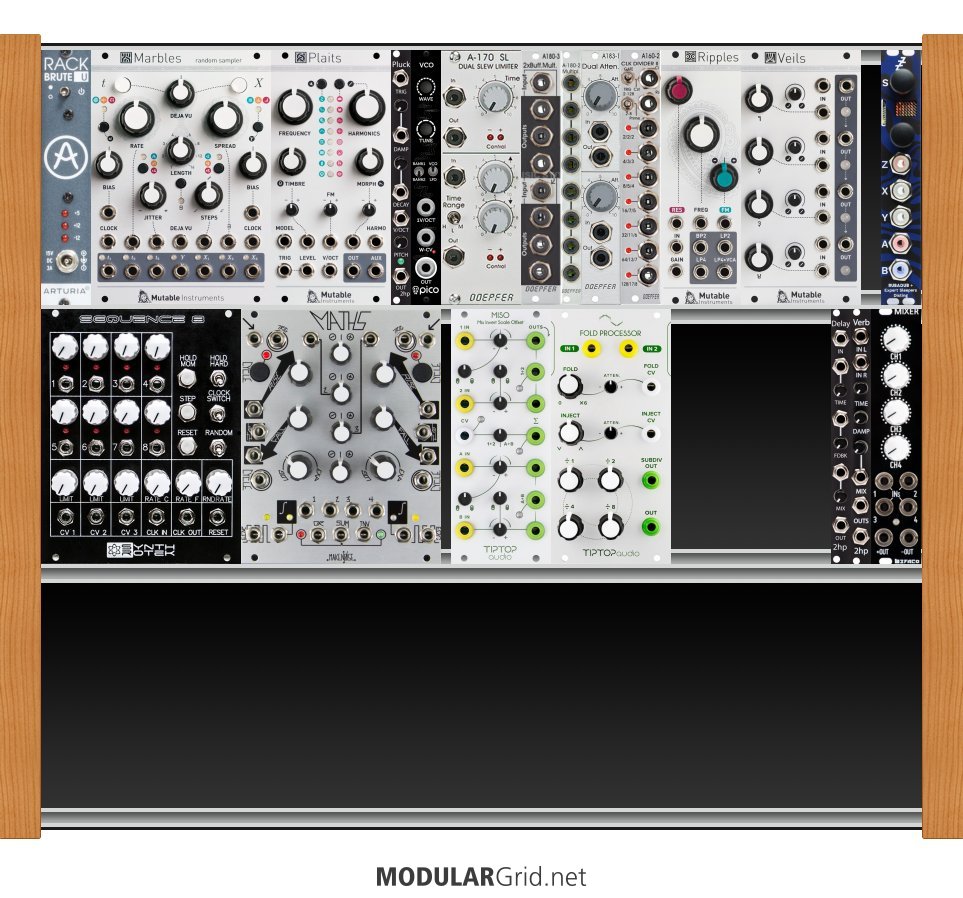
FYI, my votes for both the extra filter and the waveshaper both go to Tiptop. Their Steiner clone (Forbidden Planet) is perhaps a tad more spot-on than Arturia's (and I own a MicroBrute plus did own a Synthacon for some time), and that wavefolder + divider module is pure usefulness. Plus, a third vote for yet another Tiptop device, the MISO...one of the better CV/mod router/modifiers in a while, at a stoopid-cheap price to boot. And yes, you're going to need that MISO, because generative involves a lot of tinkering with control signals, and that module makes it easy to work them "live", like a configurable controller.
Oh, and as modulation sources go, have a look-see about jamming a Maths in there. Yeah, everyone gets those...but it's because they work as advertised, plus pairing something that can do complex slopes with the Marbles...oh, yeah, classic generative stuff there.
Well... have you tried all the things you can do with modular that you can't do with desktop (non-Eurorack). Audio-rate modulation sounds like it would be in order.
Are you planning on doing anything with effects? The Disting is useful but it's a jack-of-all-trades. A Z-DSP and a Bitbox would go well in that empty black hole that's begging for your money. I didn't see a dedicated delay module either.
You might also reward yourself with an extra filter that doesn't offer what the MiniBrute has under the hood... waveshaper/waveform folder... oh... and a couple flavors of distortion/overdrive?
I'm sorry but it feels a bit cheap to get the default answer to this, my question was specific about which strategy you would chose to build your first system over time and all I got was "beginners - read this" answers that I know and are almost all taken into account in the setups in my post:
Don't be sorry. You're the one that will be shelling out thousands of dollars... good or bad.
- I'm only interested in one row because I don't have the room nor the budget for more but any of those I suggested will already be a real a significant step up from what I currently have
If the racks above are all that you can afford now then I'd wait and save a bit more money.
- All of the modules you talk about are in all the systems I included, and there is still room...
Show me the LFOs, traditional ADSR envelopes, attenuverters,etc... especially across all three examples. You have a sliver of HP left in each example... nowhere near enough to expand your systems once you realize the deficits in each.
I looked around a lot for answers to my question and found no answer, otherwise I wouldn't have posted it.
Ever think that your question can't be reasonably answered in a definitive way?
And I know there is not one right answer to this, but I wanted to have opinions from people who've been through that already.
I have been through it and advised several others. I'm not at the Lugia level. But I've spent 30 years around synthesizers, recording studios and DAWs... for a living.
So I'll rewrite the question more concisely:
What's the best strategy when you start out?
*Start small with a few small modules and build a more complex system from there?
*Start big to get more complex and interesting modules from the beginning?
*Start with a pre-build synth voice and add modules to it?
There is no best. There's only best for you. First and foremost what's your budget range? $3000US is a good start. $2000US is okay. And $1000US will get you in the door... but isn't really worth it for what you'll get out of it.
We're all friendly here and the advice is free and valuable. People will go to great lengths to design and redesign set-ups for you. No one is being flippant or dismissive of you. But I wouldn't call anyone's advice "cheap" and expect them or others to want to help you. However, if I felt insulted I just wouldn't reply. Let's make something.
thanks....
The mention of Rebirth and Reason is a way of saying I've been messing around with music from the mid/late 90's, I never hinted that they would be of any benefit to starting Modular. They are certainly not detrimental.
I've already been doing the VCV thing as it seemed sensible before I bought anything, and its shown me that I don't want an all-singing-all-dancing module, I'd agree with darkblooCV above that simple is best.
First off I wanted to ensure I had some Stereo Output so the Intellijel Mixup, then 2hp verb cos thats stereo too so I can get a bit of simple stereo field from the limited cash and modules, Pluck makes some lovely sound so I want that to be able to spit out something vaguely ordered (2hp Euclid, I can currently trig the Euclid from TR08/09 and use Pitch CV for notes from the SH01 and have it play along in the fills), eventually Quantised with a 2hp Tune and then push that through a bit of reverb and delay (delay will be Erica Pico DSP).
At this point its simply adding a new voice to the mix with the Roland Boutiques.
Then the plan after that is to start looking at Clocking, Clock Dividers, Mults, VCA/s, LFO, maybe a Random Gate source again another 2hp, then a couple more voices and how to start bringing it all together Like you say, the important-yet-boring. Power-wise it looks like the TipTop uZeus will have me covered with the addition of another Flying bus cable for the moment.
I'll go back and edit my dumb-ass question at the start and just say 'hi' instead;-)
Enjoy your spare HP, don't rush to fill every last space, this is not like filling sticker books. Resist the urge to 'complete' your rack, its never complete so just relax.
First of all, the best starting strategy immediately proceeds from the understanding that MODULAR IS EXPENSIVE. That's not even rule #1...it's more like a basic law of physics. A primary setup is going to cost a significant amount of money...period. Even going with the less expensive makers is going to cost a chunk, since they don't make everything you'll need and since you'll want a sturdy and properly-powered case to stuff everything in.
Also, instead of feeling butthurt about Ronin's advice above, I'd suggest going back and reading it again. It might BE a "default answer"...but that's because you're already falling into default traps. Points #1 and #2 are actually extremely important and not merely flip replies. That advice is 100% spot-on and you ignore/deprecate it at your own peril. Or peril to your credit rating, because you'll wind up spending a lot to get very little in return.
Lastly, if the focus here is sound design, you might consider two other options:
1) Get a vintage modular/patchable. Something like an ARP 2600 is expensive, true, but you'll wind up learning a lot more out of something that had researched design principles behind it, plus an undeniable sound quality. And if not that, a more recent patchable based on older paradigms (such as a Buchla Sound Easel, or Kilpatrick's Phenol, which is based on Serge concepts) would make just as much sense and probably be easier to maintain.
2) Consider whether you actually need a modular synth in the first place. Frankly...and this might sound heretical on MG...you may find more use in a large, modern polysynth like a Moog One or Waldorf Quantum as far as sound design is concerned than you'd get out of a modular system that's built without proper research, funding, and system discipline. Or stay in software; have you explored the possibilities of something such as Iris2, PPG Ultimate, etc in tandem with a good library of other processing plugins?
In either of the above cases, you'll potentially wind up spending pretty much the same amount of money as a properly-scaled modular system. But they're more likely to yield an immediate result. Modular isn't about immediate results; it's more of a long-term process between the user and the instrument, and if you want those immediate results, you'd probably be better off not frustrating yourself with modular.
Uhhhhhh...I foresee problems. First of all, modular synths tend to have a specific sort of architecture; they're not put together with a "throw modules that look cool in a box, hope for the best" mentality. In fact, there's a very high risk of falling into the "sexy module" issue...lots of cool looking stuff, blinkenlichts und tvistenknobs, but you'll have neglected a lot of boring but essential modules in the process, resulting in a totally useless build that's then cost a pile of money to yield no useful results. And there are a LOT of important-yet-boring modules that have to be part of any build: attenuators, interstage mixers, OR-type summers, buffered mults (if you have enough CV destinations to require them), VCAs and the like.
ReBirth and Reason are NOT good starting environments for understanding what has to go into a proper modular build, since neither has you working at the module level on signal flow. Before proceeding further, I strongly suggest you do the following:
1) Get VCV Rack. This is a virtual Eurorack-type environment, and while things don't work precisely like they do in hardware, they do show how a build has to be put together, since the same signal path and architectural rules apply there as in a hardware build.
2) Study some classic modular and/or patchable systems, such as the ARP 2600, Korg MS-20, Moog's IIIc and System 55, the Synthesizers.com and other manufacturers' prebuilt systems, Roland's System 100 and 700, etc. All of these are successful designs, and still sought-after because they were done right. Notice how the signal flow works, what modules are incorporated, and the like. Make special note of the ergonomics, also; it might seem as if some panel space is wasted on some of these, but there are very real reasons why the various controls are located where and how they are.
3) Stay off eBay, Reverb, etc for the time being. That's just "modular porn", and it won't help you understand what you're trying to do. MG does a far better job of explaining what things do, why you might want them, why you also might NOT want them, and to explore how a build would work for you before dropping stoopid-huge wads of cash. You also get user feedback here, such as on this forum; commerce sites just can't provide that.
No one module will get you "where you want to be". That's actually a dangerous idea. Look instead at how modules interact in subsystems, and how those subsystems' signals get handed off in a modular environment. Saying that a certain module will achieve everything you need is like thinking that if you just had this specific, bespoke, boutique key on your tenor sax, you too would suddenly become John Coltrane. Ain't gonna happen. Do the work; throwing money at a problem without doing the work beforehand is simply expensive foolishness.
Use QPAS Level as VCA, use 0-Coast Contour as ADSR, 0-Coast Slope Cycle turned on
Hello,
I’m thinking about experimental drum patterns.
I already got drum modules, delay, reverb and random units and i’d like to use a filter on final drum stereo outputs..what kind of filter can i use to have something of special?
At this time my choice is for a “Makenoise QPAS”..
Thanks a lot for your help!
Cheers
Sounds pretty good advice, I'll restrain myself on eBay! (even if some stuff is what i want to end up with eventually)
the 2hp Pluck, Bell and Vowel are all full voice modules, I think these sounds get me fairly close to where I want to be, I've atched enough Youtube vids to think so at least.
Cheers
Enjoy your spare HP, don't rush to fill every last space, this is not like filling sticker books. Resist the urge to 'complete' your rack, its never complete so just relax.
Hi everyone, I'm Ryan, from Pittsburgh. I first discovered modular via a Buchla 200 series in grad school, and finally had enough savings ~6 years later to start building my own (not Buchla). Still looking to expand and get a better case, but I'm starting to get a good sense of what I want my modular to be and why.
Music is more of a hobby right now, but I'm trying to find a project to work the modular into. In the meantime, you can hear some of my 'studies' on my YouTube channel.
Also, shout out to the modular community here, and on reddit, and elsewhere. The openness and understanding of the people I've encountered online is often uplifting and helpful, and is half of why I love this instrument. I wish other parts of life were so kind.
Hi everyone. I'm new here. Glad to be the part of this community
Well first of all you want to keep in mind that a case that small isn’t going to have that many power connections and you have like 16 modules. 2hp modules are great. Especially for the size. But you’re not gonna want to fill a whole case up with them.
As far as your question about buying modules on eBay when you see a good deal; I would say don’t. I don’t know what kind of music or sounds you’re looking to get out of your modular synth, but always keep that in mind. Also I would highly recommend buying a complete synth voice first. That way you can hear it, patch it, understand it better and really figure out where you want to go from there. That’s the best way to decide the next module or modules that you’re going to need.
(I had to learn this next one the hard way)
I would never recommend buying any modulars based on looks or hype unless you’re absolutely sure that it can help get you where you want to go. Or else you’re going to be selling it and losing money. Get modules based on what you ‘need’ or modules you think could really inspire or push your modular music further. My motto is that I like simpler modules. If it has a steep learning curve, then it has to be completely worth it to me or it’s a no go.
Anyways long story short. If you don’t know already, figure out exactly what you what want your modular to do at first and then expand from there. And do a lot of research. Like a shitload of research before diving in. It’s all very very worth it. But if you come into it unprepared, it can be a less the fun experience.
No out 3. Two out 4's.
-- Guitarsenal
It's a prototype, mistakes happen :)
For anyone still looking, Flame has a newer version of this module, with the same form factor.
Here you go...
Its a work in progress, the stuff to the RH side finishing at the TM is whats in my rack now, the oher bits are waiting for spare funds etc
https://cdn.modulargrid.net/img/racks/modulargrid_976055.jpg
Enjoy your spare HP, don't rush to fill every last space, this is not like filling sticker books. Resist the urge to 'complete' your rack, its never complete so just relax.
I'm sorry but it feels a bit cheap to get the default answer to this, my question was specific about which strategy you would chose to build your first system over time and all I got was "beginners - read this" answers that I know and are almost all taken into account in the setups in my post:
I looked around a lot for answers to my question and found no answer, otherwise I wouldn't have posted it.
And I know there is not one right answer to this, but I wanted to have opinions from people who've been through that already.
So I'll rewrite the question more concisely:
What's the best strategy when you start out?
*Start small with a few small modules and build a more complex system from there?
*Start big to get more complex and interesting modules from the beginning?
*Start with a pre-build synth voice and add modules to it?
Can you share your rack that you’re wanting to put together?
A little preamble...
I've played around with music gear for years, started way back with Rebirth 338, had samplers and bits of gear etc, Stayed with Reason since the start, always for fun.
Starting my modular journey now after getting back into the Roland Boutiques, I kinda liked the idea of a Hardware ReBirth 338!
My plan is to build a kinda generative modular rack that fills the gaps around the TR08 / TR09 / TBo3 & SH01, I just sold my Korg Volca Bass as I just don't get along with its sequencer, at some point I will get a Beatstep which could have fixed the Korg but hey!
Its really tempting on ebay when you see a module you fancy come up at a good price but its all too easy to get carried away and not get to my goal of heading somewhere generative to compliment and expand on the Synth gear I already have.
So whats best?
Buy the ebay deals or hold out for my plan?
There's so much good gear out there!!!!
Yeah, its a random first post! Hi.
Enjoy your spare HP, don't rush to fill every last space, this is not like filling sticker books. Resist the urge to 'complete' your rack, its never complete so just relax.
Excellent feedback, thank you! I'm glad you think that this project is not a fool's errand.
I had not considered rack widths beyond 104hp based on typical sizes I was seeing in commercial cases, but I do now see that 126hp is indeed an option for a more authentic 2-row layout. I do plan to build the case myself out of simple box-jointed pine boards or plywood, and already have 3 sets of 84hp rails purchased for the project, but I suppose that I can save those for one of the wing blocks ... you assume correctly that I have considered building those as well if this initial project is a success!
I have not otherwise looked at genuine spring units within the context of Eurorack, but I will do some research on that. Your talk of effects reminds me of my pedal board full of guitar effects (including some nice reverbs). I ought to consider an effects send-return that I could use to patch into that. If anything, that could offload rack space used for effects in favor of what I already have.
I do like the the look of that Olitronic Pro Out, and the 2hp MIDI module is what I currently have on hand, which is the only reason why it's in there. I'll need to do some research to better understand what this unit would and would not allow for compared to other interfaces with more gate/CV outs.
The sequencer solution will probably deviate from the original, in that I don't tend to write waltzes so am not sure how I would approach a 12-step sequencer other than setting it to run 8 steps and ignoring the last 4 steps-- a strange design choice by Roland indeed! I do like the idea of a sequencer "block," but want to focus on getting this first block done before I commit to others. Block 1 is daunting enough, as I'm DIY'ing all the Pharmasonic modules, have fairly limited experience with electronics and soldering, and this is my 1st forray into Eurorack.
Based on your excellent input, I've updated my design:

I'm hoping to keep the cost for the project to about $1400US for the Pharmasonic modules and case, which is certainly better priced than buying an original System 700!
Based on your
The problem that you're encountering is that there's no cheap way to cover all of your bases. Choosing one or two oscillators means leaving other possibilities on the shelf. Not good or bad... just different possibilities.
There is no one answer. But there is some advice to be refrained over and over.
Buy a case that's bigger than what you think you will need. Most Eurorack set-ups grow over time. Not having the space for that super-awesome 24HP module you're really itching to get means having to buy additional case hardware for the privilege. Future proof your set-up for at least 1 year.
Filters, LFOs, attenuverters, output modules, and other utilities are often overlooked in most fantasy builds. You want at least one multimode filter, at least one LFO, two envelope generators, four VCAs, and an output module to go with a one or two oscillator set-up.
Don't overlook synth-voices and stand-alone synths that are Eurorack compatible. At the bottom of the pile you'll find Behringer's Neutron. But many other synth manufacturers offer their stand-alone synths and synth voices. If you're just getting into modular synth they may be a much more affordable solution that come with the basics. Besides the Neutron, check out Moog's Mother-32, Grandmother, Pittsburgh Modular's synths, as well as many, many other manufacturers.
Play in the virtual world for free. VCV Rack is a FREE modular synth environment. If you're literally learning the ins and outs of the modular synth world, it's a great way to learn more about different module types. It's not a substitute for modular. But a lot of what you will learn will carry over.
First up, if this is intended to replicate Block 1, I wouldn't have put it in this case. Erica's Monster Case (2x 126hp) is a much better fit here, with the same space, internal power, and the two-row form factor (or something better approximating it) of the original. The 84hp width cabs are better suited here to stand in for the wing cabs, and since (I assume) you have three already, you have the basis for two of your wing cabinets.
Block 1's audio input is already there...it's the "amplifier", which you'll notice has a similar gain setup to the ARP 2600 input amplifier. That extra module can therefore be eliminated.
DSP effects...uhm, no. Part of the key to the System 700 sound (just like in the Buchla 100) is the spring reverb. The electromechanical design introduces a lot of odd behaviors, nonlinearities, etc that you just can't model well with a Spin FV-1 chip (the basis for the PICO DSP). You're also missing a panner here. And the output stage needs metering to match up with the original. For the reverb, I'd be inclined to go with G-Storm's Electro Spring Tank as the drive module, then select a long Accusonics tank (mounted internally) to get the right sort of sound there. The "panner" that Block A has, though, isn't a VCA-based autopanner but a three-channel stereo mixer, everything under manual control. So something simple but stereo like Doepfer's A-138s would be just fine. Then for your output, I'd go with something that has dual balanced 1/4" outs plus metering, like Olitronik's Pro OUT. Note that all of this is available in black as well, which fits the look.
Lastly, MIDI. Now, this is something the System 700 Block 1 didn't have. However, it DID have the keyboard interface which allowed multiple channels of control for CV/gate to Block 1 and other Blocks. My suggestion would be Befaco's MIDI Thing, which gives you four channels of CV/gate, plus clocking...which might be handy if you try and replicate the sequencer block later on. And the look fits, plus it's a rather simple MIDI to CV, which would fit with the simpler implementation found on Block 1's keyboard interface.
This isn't at all a bad idea, especially since Pharmasonic has replicated the primary modules for the most part. The only stumbling block might be the sequencer, if you opt to continue on and recreate the entire System 700, because that used a weird 12-stage x 3 setup, sort of like a mutated Moog 960 etc. But continuing on while using the Pharmasonics as the basis is also much cheaper than trying to source an original System 700; even with Eurorack being more spendy these days, the resulting build would still come in at a price far less than a used original System 700.
Hi all,
I'm building a reasonable clone of the Roland System 700 "Block 1" out of the excellent Pharmasonic modules into a 9u x 84hp rack.
The Pharmasonic Modules themselves are 'immutable', in that I'm not looking to swap out/replace/improve on any of them, as that is kind of the whole point of the project, but I'm actively looking for any thoughts you have on the 'other' modules that are either needed (power supply, line-level output) or very handy (MIDI input, Audio input, DSP effects). Obviously there's not a whole lot of space left in the rack to work with, so compact is good.
Let me know what you would add (or remove) within the space available if this were your project! Any input is appreciated.
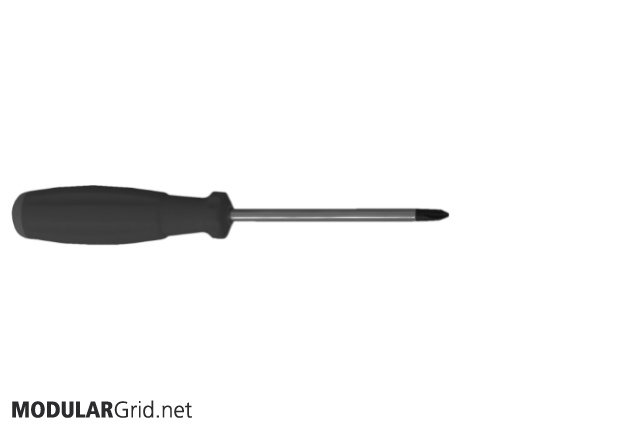
Bought an ER-301 from @carci : module in perfect condition and I have never seen a module protected for transport so well. Perfect transaction, thanks !
Today I have installed all modules in my first rack!
As I am a little bit used with desktop analog synths the only modules I have to learn is Marbles and Plaits. And they seems to be a pair that likes each other.
But there is still a big black hole in the rack that wants to be filled with modules.
Would be glad for some advices about what would be the next modules if I want to make ambient music and maybe try to learn a little bit about generative patches.
Hey guys,
I'm becoming more and more interested in modular synthesizers and spending a lot of my time trying setups on this site at the moment. I want to build a system focused on sound design so I mainly look at complex oscillators and function generators that you don't find in the traditionnal desktop synth world. The problem is that I will not be able to buy every module at once, and morover, I read everywhere that the best way to do things is to go step by step, so I'm wondering what would be the best way to proceed. Here are three options I'm condisering and I would love to have your input!
Quick precision, I'm interested in this since I've read that Blawan had designed most of the sounds on his last album/EPs with a few modules. My intention is to have a nice sound design station with randomnes, unusual modulations, happy accidents and techno in mind.
First, buying small modules over time:
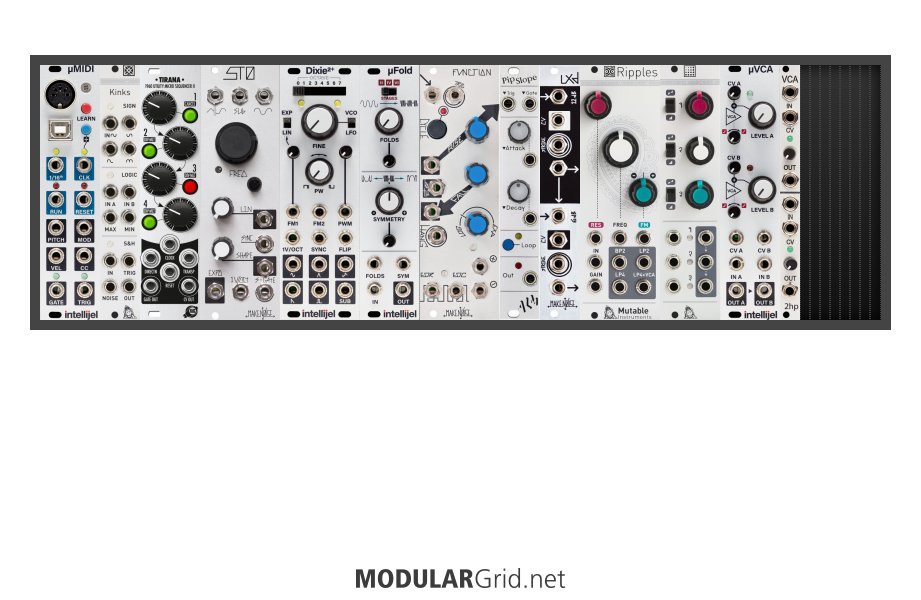
With this setup, I would start with a very basic synth voice (something like STO, Pip Slope, Ripples, Shades and 2hp VCA) and add small modules with time. This would be super simple at the beginning and become more complex with each module I hope.
Second, starting with a 0-coast
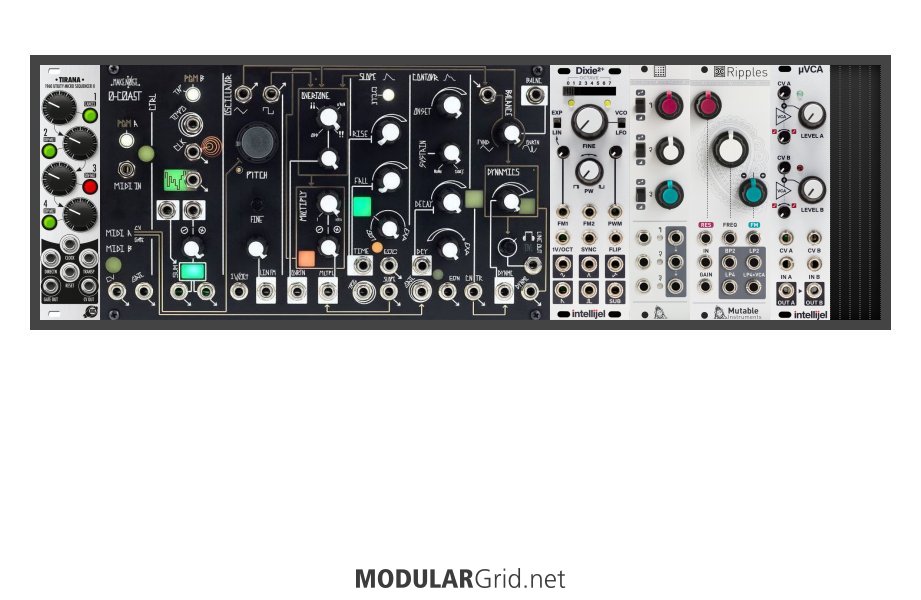
With this setup, I start with a 0-coast, which would be the initial budget, and then add modules depending on what I need. This seems cool because the 0-coast looks like and already complex synth with a lot of exotic possibilities. And it would also be the cheapest option :)
Third, big modules:
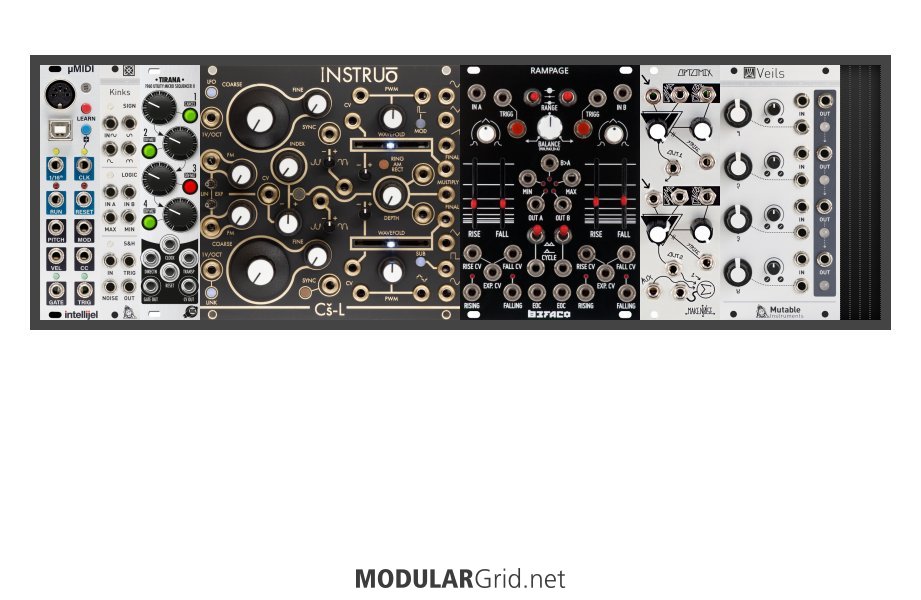
This seems like the most interesting setup from a sound design point of view, but it seems like a "buy everything at once" system as everything seems important for it to work properly (except the sequencer)
What do you think? What would be the most intelligent choice? In what order would you buy modules? Are there missing ones? Or useless ones?
(I have not decided on the specific modules yet, like which oscillators/function generators/filters, the question is more focused on the best method to build a system and what kind of modules I want to place in it, but if you have recommendations on modules I should change or consider instead, please say! :) )
Thanks a lot!
hi I built this rack with the goal of making a live techno, with the experience I was thinking of adding a distortion 308 or a Dusting mk4 and replace Rings by Honda Piston Mk3.
What do you think?
Hey PCHMR!
If live playing is your focus, I might suggest you think twice about the Disting (depending what you’re intentions are). While it’s great to have a Swiss Army knife in a small system, the Disting is the worst interface I’ve ever come across in eurorack, and you will always need a manual or cheat sheet out unless you just have one setting you love and set-and-forget. But if you if do set and forget, you’re more than likely to find a module that does that thing way better than the Disting.
Here’s my pitch for keeping it though: if you’re in a learning/growing phase and you’d like to have it to better understand different functions of modules, and also to have something which will make you realize “oooohhhh, if I had this kind of thing I could do X”, then maybe it’s a good thing to start with.
I say all this because I have one and this has been my journey with it.
www.macromicromusic.com
I'm not too jazzed about the drum module choices, tbh. While the Tiptop Hats909 module is a good choice, the Jomox just strikes me as pointlessly expensive and a space-hog for what it does. Erica's Bass Drum would be a better choice if you need that level of control over the kicks...it's less than half the cost, takes up 6 hp less. And the Basimilac Erectus Blovio or whatever nonsense it calls itself is, again, expensive for what it does and...sorry, but I'm of the opinion that the panel looks like utter shite and poses issues if you want to use this effectively in a live, low-light venue. Having done plenty of that exact sort of thing back in the 1990s, I can speak from experience when I say that you want clean, clear panel layouts, not something that requires excessive squinting and puzzling over. Lastly, you might find programming easier if you use a multitrack trigger sequencer such as Tiptop's Circadian Rhythms for the drum programming alone, leaving the Hermod to deal with bass/bleep/pads/leads and clocking in general.
One way I would suggest making ample use of a separate trigger sequencer, btw, would be to go with a Delptronics LDB-2e/2x pair. That would then give you much of the TR-808/TR-606/CR-78-type soundset, with the 2x expander allowing some extra control tricks like CV pitch over several of the sounds, etc.
Another point: you should find a way to set this up as a stereo device. Right now, it's not really that, despite the Rosie having a stereo out (of a sort). Drums/percussives are much more effective when spatialized across a stereo field as opposed to all coming out of one point. If this is in an Intellijel 7U cab, you need to implement the stereo I/O in the tile row as well as putting a QuadrATT in there for mixing/attenuation duties. Plus, if the Circadian Rhythms is limiting in capabilities, you can add a Steppy 1U up there for four additional trigger lanes.
Lastly, envelopes. There's no EGs in here, unless you count the Maths (which I don't...it has much better uses here, especially considering the lack of any other modulation sources), and you have plenty of things that NEED envelope control, such as your VCAs, VCFs and...yep...the Rings, which you probably should keep, as it would make a nice resonating cavity-type effect before your Clouds clone, and also do some to help out the stereo imaging as a result.
Main riff is Plaits, modulating the model input to switch between all the melodic and some of the percussion algorithms. The melody and "electric piano" towards the end is Arturia MicroFreak. Klavis Twin Waves does the bassline and Elektron Rytm the drums.
You should definitely check out Strymon AA.1
Works very well with guitar pedals
hi I built this rack with the goal of making a live techno, with the experience I was thinking of adding a distortion 308 or a Dusting mk4 and replace Rings by Honda Piston Mk3.
What do you think?
My new generative patch to learn the melodic possibilities of Mutable Instruments Marbles and two Plaits.
I love classical nocturnes by Frederic Chopin and Claude Debussy, so this one is inspired by their works.
Hope you will like it.
Bought my first Modules today.
My dealer had some of them in Stock:
Chords V2
ALM Tangle Quartet
2HP Pluck
Xaoc Batumi
Maths
Morphagene
MI Marbles
Also the Ladik arrived today.
So I still need a small mixer in my Rack to mix the Soundsources together. Would the Bastl ABC be good?
We are discussing this a while. It's a good idea and absolutely makes sense but it's also quite some work. Might come at some point...
Beep, Bopp, Bleep: info@modulargrid.net
so with some luck I’ve traded into modular. I’m just looking for opinions on what will be coming in the mail in the next few days. I’m looking to take this into ambient territory and also add some drum modules. As of right now I will just be clocking with sq-1. Thanks in advance for any opinions. https://cdn.modulargrid.net/img/racks/modulargrid_973182.jpg
so with some luck I’ve traded into modular. I’m just looking for opinions on what will be coming in the mail in the next few days. I’m looking to take this into ambient territory and also add some drum modules. As of right now I will just be clocking with sq-1. Thanks in advance for any opinions. https://cdn.modulargrid.net/img/racks/modulargrid_973182.jpg
Maybe one day this will be a problem but for now I already have a 6U104HP DIY flightcase (260€) and lots of room (because the neutron goes). Main reason I prefer to rack these semimodular synths is for transport and to keep the system as compact and tidy as possible. If one day I end up needing more room I can always put them back in their case.
The expensive part of eurorack is not the case, is the modules. A 6U104hp full of eurorack modules goes for around 4000-5000€, the 270€ spent on the case is just a 5%
As has come up on here numerous times, putting patchables that already have a powered case into another case for which you need power isn't a very economical move. Basically, you're paying to case and power these patchables twice...and given the cost per hp of space in a Eurorack cab with power, that's costing you perhaps a few hundred to do in terms of loss of Eurorack cab space.
Hello,
I got into modular world quite recently; I started with a Neutron and DFAM and added few things.
I work a with a computer and also stand alone; anything from experimental/IDM to Dark/industrial techno
My actual set up looks like this:
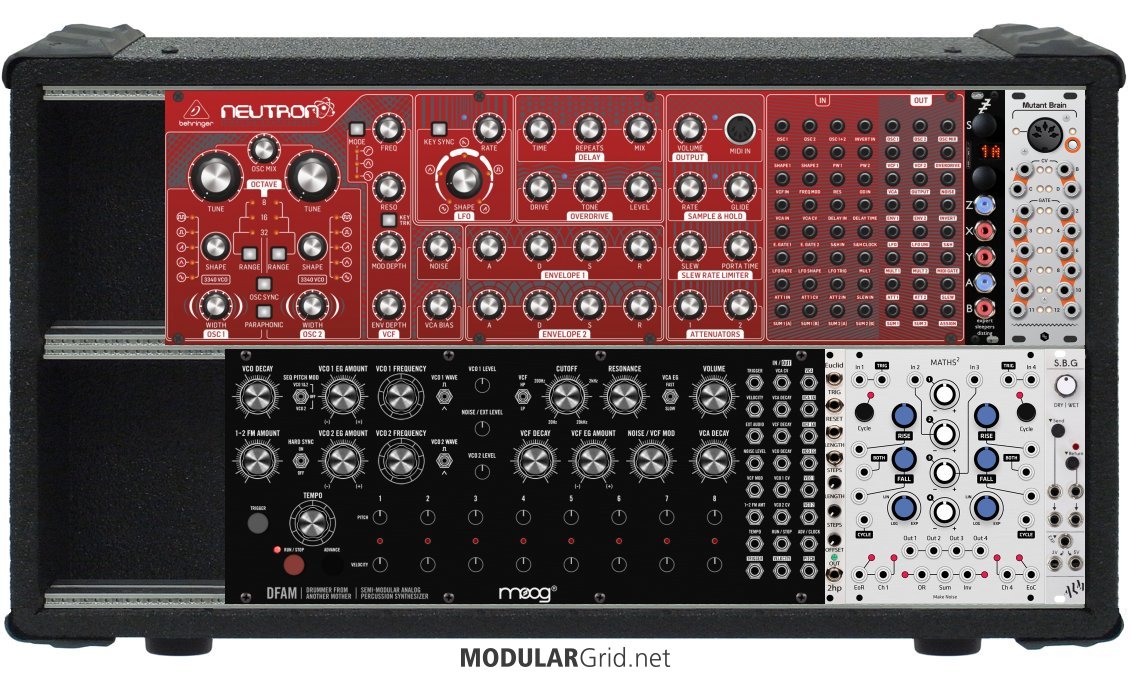
But I decided to sell the Neutron (despite people complaining about behringer is what got me into modular),; although has lots of patching options the overall sound is not for me . I even end up using the DFAM more for synth sounds. I will also sell the hexinverter Mutant brain; 0-coast has midi, I also own a Korg SQ-1 and my audio interface (presonus studio 1810) can send CV. So I am served (Mutant brain was the first one of these).
I also own a Bastl Kastle V1.5 I am selling too; I barely use it.
I have just bought an 0-coast ( I really like the way it sounds) and a mutable instruments links
I am considering two options, either move to a smaller 84hp case or keep the 104hp one (although there will be quite a lot of empty space for a while)
So, so far I own and will keep DFAM, 0-coast, Maths, ALM-06 (really useful if you own guitar pedals) Disting MK4, and links. I also own a Korg SQ-1, Volca Kick and Volca Drum and¡ a Kaoss Pad 3. The mixer is a Behringer QX1204USB
I will probably add a behringer crave (low cost alternative to Mother 32, which pairs well with DFAM) and a Roland TR8S(I prefer a Drum Machine over a sampler like Digitakt, and can not afford Analog Rytm)
I plan to add a VCA (either Intellijel uVCA/Quad VCA or Veils), maybe kinks. I do not want to add many modules at once, I have just scratched the surface of maths and Disting Mk4.
What modules do you think I should or could add to this set up first (I hear Pamela´s workout, ModDemix, and other)..maybe add the VCA/quad VCA or wait, what other utilities ..maybe another filter?
I do not mind (In fact I prefer) to buy second hand and/or old/mkI versions
Regards
Javier
Actually, you could possibly use some more VCAs...the Veils is obviously for the audio, but having a few more linear/DC-coupled ones for CV level modulation would be useful here since you've got an ample amount of modulation sources. Other than that, I'd reorder everything so that your power supplies aren't next to audio path modules...especially not next to the Ears, which stands the highest chance of susceptibility to noise/garbage.
-- Lugia
Hmmm.. originally I thought 2*104hp would be very much sufficient, but now I can see the 3rd row is alluring me...I was actually thinking to get a MI Blinds for the CV modulation, and perhaps some noise generators, more effects modules like the Erica Synths Black Hole DSP v2, the “everyone’s favourite” disting mk4.....(that’s half of the 3rd row already)
I never thought audio sources next to power supplies would cause noise, thanks for letting me know!
Yes the EMW switch interface 1 is just about exactly what I was looking for! Thanks as always , Lugia.
Actually, you could possibly use some more VCAs...the Veils is obviously for the audio, but having a few more linear/DC-coupled ones for CV level modulation would be useful here since you've got an ample amount of modulation sources. Other than that, I'd reorder everything so that your power supplies aren't next to audio path modules...especially not next to the Ears, which stands the highest chance of susceptibility to noise/garbage.